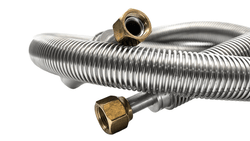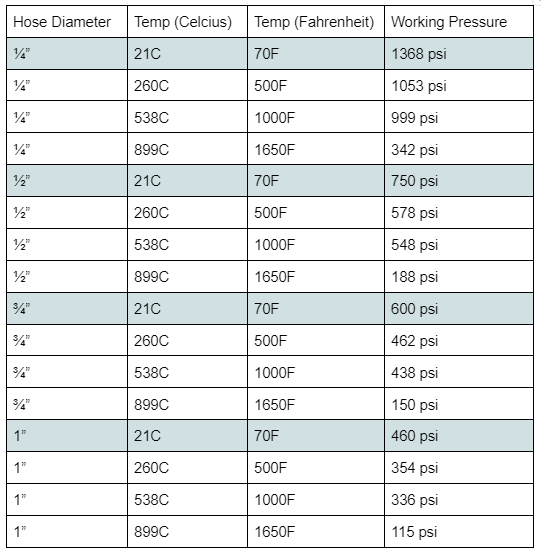You have no items in your shopping cart
Advantages of Vacuum insulated Tubing
- Posted on
- Posted in Chilling Solutions, Cryogenic Equipment, Heating Solutions, Hosing
- 1

Vacuum Insulated Tubing
Many industries such as oil and gas fields depend on vacuum insulated tubing that has a high thermal resistance for transporting either extremely high or low temperature solutions such as liquid nitrogen or superheated, high pressure steam injection. Ensuring a hose is rated for liquid or gaseous transfers at such extreme pressures and temperatures is key to safety, efficiency, and an overall successful operation.
There are already a number of hoses that use basic foam, rubber, or some other type of insulating material to prevent thermal loss during transfer. However, these types of hoses are usually only rated for warm to hot temperatures up to about 200F (93C), and mostly not rated for low temperatures at all. Even low temperature hoses for high powered chillers are only rated down to -130F (-90C).
Our collection of vacuum insulated, stainless steel flexible tubing is rated for extreme temperature ranges and pressures. At room temperature, our ¼” high pressure line has a maximum allowable working pressure (MAWP) of over 1300 psi. That same ¼” hose can be used as cryogenic tubing as it can handle temperatures as low as -450F (-267C) all the way up to high temperatures of 1650F (900C). With such an extreme range of pressure and temperature, these hoses are suitable for almost any cryogenic material or heated hydrocarbons in gas production conditions. Stainless steel is also resistant to most chemicals, so users do not need to worry about any degradation or contamination to their solution.
Operators that deal with challenging oil production at an extreme operating temperature need a high performance pipe with little maintenance. Distilling gasses from a reservoir for purification will require a pipe or tubing with low risk and a high max operating temperature. With a casing that can withstand well over a thousand psi, this flexible tubing can easily replace a rigid pipe manifold for distillation, injection, and purification applications.
Here are some specs for temperature and pressure ratings on our vacuum insulated tubing:

Advantages of using vacuum insulated pipes
-Mitigate heat loss with vacuum insulation
-Maintain cryogenic temps and solutions integrity
-Prevent evaporation, loss of gas, and leaks
-Eliminate formation of ice or frost, and their melting into a wet spot on the floor
-Minimize excessive vapor and the appearance of ice
-Easily fit into any system with flexible tubing
-Economic incentives with efficient thermal preservation, means less work on heating and chilling equipment
Thermal Resistance with Vacuum Insulated Tubing
There are a few ways that a vessel can lose heat energy, through radiation, conduction, and convection. When analyzing materials, their thermal resistance is their capability to limit the flow of heat through itself. Thermal insulation can be measured as the inverse of thermal conductivity coefficient. The more resistant a material is, the better it is for insulating and preventing heat from flowing through it.
Since a vacuum is deprived of nearly all molecules, it prevents almost all loss of heat through conduction. Convection occurs when there is a gas present to act as a carrier that transports heat. As a vacuum is void of any gasses, there can be no loss of heat energy through convection. Common forms of insulation that are dependent on air and its low thermal conductivity because their molecules do not come into contact with each other very often. Classic plastic foam insulation uses this property by housing numerous air bubbles that slow the transfer of heat.
Vacuum insulated tubing uses the opposite fundamental properties of foam insulation, as vacuum tubing has a layer that is completely lacking of air that could lead to a loss of energy. Even when transferring cryogenic materials like Liquid Nitrogen, these tubes will not develop frost or condensation and barely drop a few degrees below the ambient room temperature. Industrial gas suppliers are aware that the best way to transfer cryogenic materials is through vacuum insulated tubing, but most of these hoses are rigid pipes that are difficult to maneuver and adjust. Goldleafs collection of vacuum tubing consist of flexible stainless steel hosing that can easily be manipulated to fit into any application.
Our vacuum insulated tubes are made of:
-The inner layer tube that holds the solution
-The outer layer tube that is exposed to ambient air
-Space in between the two layers that is vacuumed to remove any air
-Flexible 316L stainless steel tubing
Conclusion
These vacuum insulated hoses are available in lengths from 2ft - 20ft with options to make any length in between at 1 ft increments. Hose connections are tube stub compression fittings that maintain the high pressure limit of the hoses, as classic threaded fittings are not suited for the extremely high pressures that the hoses can handle.
Overall, vacuum insulation and high pressure hoses are practically required for applications that require extreme parameters. Cryogenic materials are expensive and operators do not want to lose any of their solution as it warms up through transfer and becomes gaseous and thus unusable. On the other hand, heated hydrocarbon gasses are extremely dangerous, and it is important to use a hose that can handle the high pressures and temperatures that can come from distilling volatile gasses.
These hoses are perfect for cryogenic to superheated gasses alike. If you would like to discuss lead times and custom lengths, give us a call anytime to go over details. See the product page for more specifications, and let us know about any questions you may have. Customers can expecting shipping throughout the USA and Canada, please reach out for international shipping inquiries.





Nice post. <a href="https://gianacliscaldwell.com/">vacuum</a>